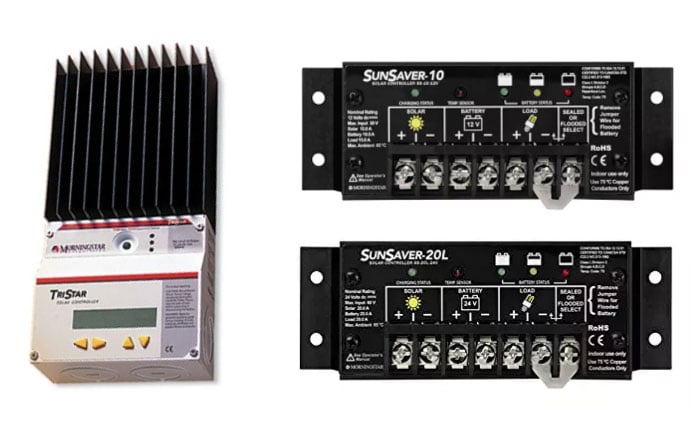All renewable energy (RE) systems with batteries should include a charge controller. In this article we’ll principally be referring to solar charge controllers. Charge controllers prevent battery overcharging and also prevent the batteries from sending their charge back through the system to the charging source (i.e., the solar panels). Think of a solar charge controller as a battery nurse — its job is to monitor the battery bank, feeding it what it needs and checking its vital signs. Since a solar controller does its work in line between the solar panel array and the batteries, it would make sense that its selection and sizing would be influenced by those components. And that’s exactly the case.
How do I size a PWM solar charge controller? Voltage and amperage (or current) are the parameters we use in solar charge controller sizing. The solar controller must be capable of accepting the voltage and current produced by the DC source (usually solar panels) and delivering the proper voltage and current to the batteries. This situation might make you think that the DC source, charge controller and batteries must all share a common voltage. While that is one system design strategy used in many installations, it’s not the only one. More on the alternatives later. For now, it’s one voltage for everyone!
Technically speaking, the DC source must always have a higher operating voltage than the battery bank in order for current to flow from one to the other. A handy way to remember this fact is the statement, “Current flows downhill.” For the purpose of this discussion, we’ll use nominal voltage which means common battery voltages. Nominal voltage in this sense is synonymous with battery voltage. Since batteries (where they are used) are in many ways the heart of an RE system, we can call the bank’s voltage the system voltage. The system voltage selected for any given installation is usually determined by the application.
For example, if you are using a 12V battery bank, and you are using a PWM (Pulse Width Modulation) charge controller, you must also use a 12V solar panel array. A 12V solar panel doesn’t actually output 12V. As we mentioned earlier, the solar panel voltage must be higher than the battery voltage to charge it. So a 12V solar panel will typically have about 18V Vmp (Voltage Max Power) and around 22V Voc (Voltage Open Circuit). You can find these numbers either on the solar panel spec sheet, or on the sticker on the back of the solar panel. If you can’t find either of these, you can measure the Voc of the solar panel with a voltmeter, as seen in this video. Likewise, if you have a 24V battery bank, you must use a 24V solar panel array. Same with 48V, both the battery and the panel array voltage must match. If you have 12V panels and a higher voltage battery bank, you must wire the panels in series, plus to minus, to increase the voltage of the solar array. Two 12V panels in series makes a 24V array, and four in series makes 48V.
Now that we understand the voltage requirement for the PWM charge controller, let’s talk about the current. A PWM charge controller is rated by the maximum current it can take from a solar panel. The current of the solar panel is also on the spec sheet of the panel. It also has two ratings, the Imp (Current at Max Power) and Isc (Short Circuit Current). Since the Isc is always higher than the Imp, you must use the Isc. Plus, to take into account that the sun may occasionally shine brighter than the standard test condition (STC) that the panels are rated at, you must add another 25% to the current.
For example, if a 150W 12V solar panel has an Isc of 8.86A, then you must use the equation 8.86A x 1.25 = 11A. You should always round up to the next available size controller, like a 12A, 12V controller.
If you have multiple parallel strings of solar panels, wired plus to plus and minus to minus, you would simply multiply the number of parallel strings by the Isc, and then by the derating of 1.25. For example, three parallel strings of the 150W 12V solar panels would use the equation 8.86A x 3 strings x 1.25 = 33.2A. Since the panels are all in parallel, the voltage of the array stayed at 12V, so you still need just a 12V charge controller, but one that can handle at least 33.2A, like the 35A 12V or 24V Xantrex C35. Note that it can be used for either a 12V or a 24V system. It can only support one of the voltages, it does not change a 24V array for a 12V battery. Being PWM, it must have both the panel and the battery bank the same voltage.
If you have a larger solar array, with multiple panels in series, plus to minus, increasing the voltage, the equation for finding the current for the charge controller is the same. Because wiring in series only increases volts and not amps, if you have four 12V 150W solar panels in series, the current the charge controller must handle is 8.86A x 1 string x 1.25 = 11A. However, because you now have a 48V solar array, you must select a charge controller that can support a 48V battery bank, like the 12V/24V/48V 40A Xantrex C40.
Alternatives
In some cases, it makes sense to have a PV system with a higher-voltage array to reduce voltage drop over long distances; yet you may need a lower-voltage battery bank to run some appliances (e.g., a 48V array and a 12V battery bank). In those instances you can utilize the special powers of a different class of charge controllers. They represent the alternative strategy we hinted at earlier: it’s a charge controller technology that can make them “smart” enough to handle DC sources with substantially higher voltages than the batteries they’re feeding. The smart ones are called MPPT (Maximum Power Point Tracking) charge controllers. You can read about sizing MPPT charge controllers here.
Plan Ahead!
What you don’t plan for can come back and bite you in the behind! Ambient conditions of sunlight intensity and temperature can boost your PV array voltage and current output and put your charge controller at risk. Save yourself money and hassle by planning your RE system carefully, making appropriate allowances for conditions — however unlikely — that can affect component sizing calculations. Over time, the money you save can go toward expansion of your RE system.



